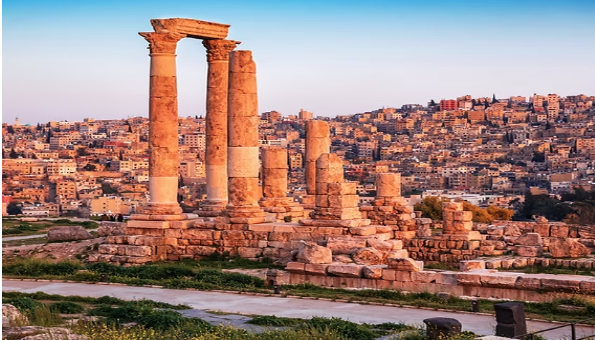Traveling from Amman to Egypt represents one of the Middle East’s most popular cross-border journeys, connecting Jordan’s vibrant capital with Egypt’s ancient wonders and modern attractions. This route serves millions of travelers annually, including pilgrims, tourists, business travelers, and regional residents, making it a well-established corridor with multiple transportation options catering to diverse needs and budgets.
The Amman to Egypt journey spans approximately 400 kilometers to Cairo via the most direct routes, though actual distances vary depending on chosen transportation methods and final destinations within Egypt. Understanding the available options, visa requirements, border procedures, and logistical considerations ensures smooth travel experiences while maximizing time for exploration in both countries.
Flight Options: Fastest Amman to Egypt Connection
Air travel provides the most efficient method for traveling from Amman to Egypt, with Queen Alia International Airport offering multiple daily flights to Egyptian destinations. Royal Jordanian Airlines operates frequent services to Cairo International Airport, typically requiring 1 hour and 15 minutes flight time, making it the preferred option for time-sensitive travelers.
EgyptAir provides additional Cairo connections with competitive pricing and convenient scheduling, often featuring promotional fares for advance bookings. The airlines’ partnership agreements enable seamless connections for travelers continuing to other Egyptian cities or international destinations beyond Cairo.
Direct flights from Amman to Red Sea destinations including Sharm El Sheikh and Hurghada operate seasonally, primarily during peak tourism periods from October through April. These services cater to beach resort travelers and diving enthusiasts, though schedules may vary based on demand and seasonal considerations.
Budget airlines occasionally offer promotional routes between Amman and Egypt, though service frequency and reliability may vary compared to established carriers. Travelers should verify baggage allowances, schedule consistency, and customer service standards when considering low-cost options for this route.
Flight booking strategies significantly impact costs, with advance reservations typically providing 20-40% savings compared to last-minute purchases. Tuesday and Wednesday departures often feature lower fares, while avoiding peak travel periods like religious holidays and summer months can result in additional savings.
Overland Transportation: Road and Bus Services
Overland travel from Amman to Egypt involves crossing the Sheikh Hussein Bridge (Jordan River Crossing) into the West Bank, then continuing through Israeli territory to reach the Egyptian border at Taba. This route requires careful planning due to multiple border crossings and varying political conditions that may affect transit times and requirements.
Private car travel offers maximum flexibility but requires comprehensive documentation including international driving permits, vehicle registration, and multiple insurance policies covering different territories. Border crossing procedures can consume several hours, particularly during peak travel periods or heightened security situations.
Regular bus services operate between Amman and Cairo through established tour operators and transportation companies. These services typically require 12-18 hours including border crossing time, rest stops, and potential delays at checkpoints. Air-conditioned coaches provide reasonable comfort levels, though journey duration makes this option suitable primarily for budget-conscious travelers.
The overland route passes through diverse landscapes including the Jordan Valley, Palestinian territories, Israeli coastal plains, and the Sinai Peninsula, offering scenic variety and cultural insights not available through air travel. However, political considerations and security conditions may occasionally disrupt services or require route modifications.
Ferry Connections via Aqaba
The Aqaba to Nuweiba ferry route provides an alternative connection from Jordan to Egypt’s Sinai Peninsula, though it requires additional overland travel from Amman to Aqaba port. This option appeals to travelers seeking unique experiences or those continuing to Red Sea destinations within Egypt.
Ferry services operate several times weekly, with journey times typically ranging from 3-5 hours depending on sea conditions and vessel type. High-speed ferries reduce travel time but may cost more than conventional services, while overnight ferries provide sleeping accommodations for longer crossings.
Aqaba port facilities include passenger terminals, parking areas, and basic amenities, though travelers should arrive well in advance of departure times to complete check-in procedures and security screening. Vehicle transportation is available for travelers planning to continue overland travel within Egypt.
The ferry route offers spectacular Red Sea scenery and opportunities for marine wildlife observation, particularly during calmer weather periods. However, sea conditions can affect scheduling and passenger comfort, making this option less reliable than other transportation methods.
Visa Requirements and Documentation
Egyptian visa requirements for travelers from Amman vary based on nationality, with most visitors requiring advance visa applications through Egyptian consulates or authorized agencies. The Egyptian Embassy in Amman processes visa applications for Jordanian residents and provides information about current requirements and processing times.
Electronic visa systems (e-Visa) have simplified application procedures for eligible nationalities, allowing online applications with faster processing times and reduced embassy visits. Tourist visas typically allow 30-day stays with single or multiple entry options depending on travel plans and nationality.
Passport validity requirements mandate minimum six-month validity from entry date, with sufficient blank pages for entry stamps and visa placement. Travelers should verify current requirements well in advance, as visa policies may change based on diplomatic relations and security considerations.
Transit passengers continuing to other destinations may qualify for different visa requirements, though all travelers entering Egyptian territory must complete appropriate documentation regardless of intended stay duration.
Border Crossing Procedures and Tips
Amman to Egypt overland travel involves multiple border crossings that require patience, proper documentation, and understanding of varied procedures. The Allenby Bridge crossing (King Hussein Bridge) represents the primary route, though political conditions may occasionally affect accessibility or processing times.
Border officials at each crossing point require passport presentation, visa verification, and may conduct baggage inspections or vehicle searches. Carrying cash in appropriate currencies (Jordanian dinars, Israeli shekels, Egyptian pounds) facilitates fee payments and reduces delays during crossing procedures.
Photography restrictions apply at border areas, with electronic devices potentially subject to inspection or temporary confiscation. Travelers should respect security protocols, avoid political discussions, and maintain courteous interactions with border officials throughout the process.
Peak travel periods including religious holidays, summer months, and weekend periods typically result in longer processing times and increased congestion at border crossings. Planning extra time and maintaining flexible schedules helps accommodate potential delays without compromising travel plans.
Cost Considerations and Budget Planning
Transportation costs from Amman to Egypt vary significantly based on chosen methods, booking timing, and service levels. Budget travelers can expect bus services to cost $30-50, while flights typically range from $150-400 depending on advance booking and seasonal demand.
Private transportation costs include fuel, tolls, border fees, and potential accommodation expenses for overnight stops. Vehicle insurance requirements across multiple territories can add substantial costs, while parking and security fees at border crossings contribute additional expenses.
Hidden costs may include visa fees, departure taxes, baggage handling charges, and meals during extended travel periods. Comprehensive budget planning should account for currency exchange rates, tip expectations, and potential delay-related expenses such as additional accommodation or meal costs.
Travel insurance becomes particularly important for Amman to Egypt journeys due to multiple border crossings, varied political conditions, and potential medical emergency situations in different countries. Policies should cover medical evacuation, trip interruption, and coverage across all transit territories.
Cultural and Practical Considerations
Travelers from Amman to Egypt experience significant cultural transitions, from Jordan’s blend of traditional Bedouin and modern Arab culture to Egypt’s unique fusion of ancient heritage and contemporary life. Understanding cultural differences enhances travel experiences and facilitates smoother interactions with local communities.
Language considerations include Arabic variations between Jordan and Egypt, though Modern Standard Arabic and English are widely understood in tourist areas. Learning basic Egyptian Arabic phrases can enhance communication and demonstrate cultural respect to local residents.
Currency exchange strategies should account for multiple currencies potentially needed during travel, including Jordanian dinars, Israeli shekels, and Egyptian pounds. Exchange rates vary between countries, making advanced research beneficial for budget optimization.
Religious considerations may affect travel timing, particularly during Ramadan, major Islamic holidays, or Jewish holidays that could impact border crossing schedules and service availability. Planning around religious calendars helps avoid potential disruptions and demonstrates cultural sensitivity.
Conclusion
The Amman to Egypt route offers diverse transportation options suitable for various traveler preferences, budgets, and schedule requirements. Whether choosing efficient air travel, scenic overland journeys, or unique ferry connections, each method provides distinct advantages and cultural experiences that contribute to comprehensive Middle Eastern adventures.
Success in traveling from Amman to Egypt depends on thorough advance planning, understanding documentation requirements, and maintaining flexibility for potential delays or route changes. The journey itself becomes part of the travel experience, offering opportunities to witness regional diversity, interact with different cultures, and appreciate the historical connections between these neighboring nations.
Proper preparation, realistic expectations, and cultural sensitivity ensure that the Amman to Egypt journey enhances rather than complicates your travel experience, setting the stage for memorable exploration of Egypt’s extraordinary attractions and Jordan’s remarkable heritage.
Frequently Asked Questions
Q: Do I need a visa to travel from Amman to Egypt? A: Most nationalities require Egyptian visas, available through Egyptian consulates, e-Visa systems, or visa-on-arrival for eligible countries. Jordanian residents can apply at the Egyptian Embassy in Amman. Check current requirements based on your nationality before travel.
Q: What’s the fastest way to travel from Amman to Egypt? A: Flying is fastest, taking approximately 1 hour 15 minutes to Cairo. Royal Jordanian and EgyptAir operate multiple daily flights. Direct flights to Red Sea destinations are available seasonally but less frequent than Cairo services.
Q: Can I drive from Amman to Egypt? A: Yes, but it requires crossing through Israeli territory and multiple border controls. You’ll need international driving permits, comprehensive insurance, and significant time for border procedures. The journey typically takes 8-12 hours including crossings.
Q: How much does it cost to travel from Amman to Egypt? A: Costs vary by method: flights range $150-400, buses cost $30-50, private car travel costs $100-200 including fuel and fees. Additional expenses include visas ($25-60), meals, and potential accommodation for overland travel.
Q: Is the Aqaba to Nuweiba ferry still operating? A: Yes, ferry services operate several times weekly between Aqaba and Nuweiba, taking 3-5 hours. However, you need to travel from Amman to Aqaba first (4-hour drive), making this a longer but scenic alternative route.
Q: What documents do I need for overland travel from Amman to Egypt? A: You need a valid passport (6+ months validity), Egyptian visa, and potentially Israeli transit visa depending on nationality. Vehicle documentation, international driving permits, and insurance are required for private car travel.
Q: How long does the bus journey take from Amman to Egypt? A: Bus services typically require 12-18 hours including border crossings, rest stops, and potential delays. Journey time varies based on border conditions, traffic, and security procedures at multiple checkpoints.
Q: Are there any restrictions on items I can carry from Amman to Egypt? A: Standard international travel restrictions apply, with additional scrutiny at border crossings. Avoid political materials, excessive cash amounts, and items that might be considered suspicious. Check current restrictions for electronics and medications.
Q: When is the best time to travel from Amman to Egypt? A: October through April offers optimal weather conditions and more reliable transportation schedules. Avoid major religious holidays when borders may be more crowded. Summer heat can make overland travel uncomfortable.
Q: Can I book connecting tours from Amman to Egypt? A: Yes, many tour operators offer combined Jordan-Egypt packages including transportation, visas, and accommodations. These packages often provide better value and handle logistics, though they may limit flexibility in travel planning.


















